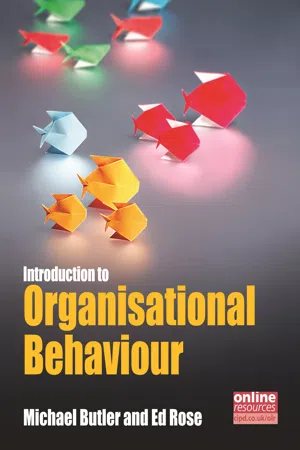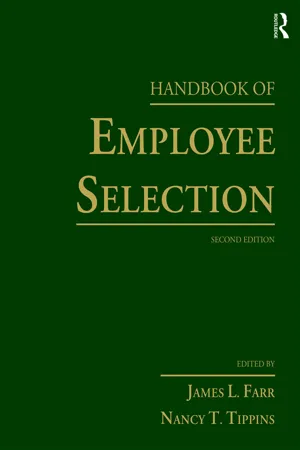Business
Personality at Work
Personality at work refers to the unique set of traits, behaviors, and characteristics that individuals exhibit in a professional environment. It encompasses how individuals interact with colleagues, approach tasks, and handle challenges. Understanding personality at work is crucial for effective team dynamics, communication, and leadership, as it influences work styles, decision-making, and overall organizational culture.
Written by Perlego with AI-assistance
Related key terms
6 Key excerpts on "Personality at Work"
- eBook - ePub
- Michael Butler, Ed Rose(Authors)
- 2011(Publication Date)
- CIPD - Kogan Page(Publisher)
Each of the Big Five has shown importance in some aspect of organisational behaviour, and over the last two decades developments in research and perspectives have allowed us to develop a fuller understanding of the relations of personality and work outcomes. Personality traits have been identified as influential in:- promoting more effective individual job performance
- promoting organisational citizenship behaviour
- determining leadership effectiveness
- building effective teams
- predisposing people to be more satisfied and committed at work
- promoting key aspects of motivation
- people’s career interests, choices, and decisions.
The combination of personality and cognitive ability (intelligence) gives a particularly powerful combination of attributes for understanding individual differences at work, and their influences on organisational behaviour and job success. However, all of the influences of personality must be viewed in context, and a focus on individual differences is always only half of the story when it comes to organisational behaviour. Personality exerts its influence on behaviour that is nested or located in particular organisations and particular contexts and situations. So when you wrote down the characteristics of your ideal colleague or employee, keep in mind that the right traits are crucial – but also that the way those traits are expressed in behaviour is about the way people are managed, and, of course, the way in which you interact with them.End notes
1 See also Chapter 6 .2 See also Chapter 6 .3 See also Chapter 10 .4 See also Chapters 5 and 17 .5 See also Chapter 5 .6 See also Chapter 6 .REVIEW AND DISCUSSION QUESTIONSREVIEW QUESTIONS 1 - eBook - ePub
- James Skinner, Bob Stewart(Authors)
- 2017(Publication Date)
- Routledge(Publisher)
The workplace exposes everyone’s personality. This is because working in an organizational setting demands frequent interaction with other employees, and the exchanges that follow are in part shaped by each individual’s personality. Sometimes dealing with workplace personalities can present a bigger challenge than the work itself. Interpersonal disputes and tensions are often explained by problems resulting from a ‘personality clash’.So, what exactly is personality? It is often associated with terms like ‘temperament’, ‘disposition’ and ‘character’, and thus says something about the ways in which individuals present themselves to others in different social situations. Personality thus has a lot to do with the visible aspect of someone’s character. Additionally, personality is more than exhibiting a specific trait; rather, it is about the embodiment of a collection of qualities. Overall then, personality can be broadly described as the organized pattern of behavioural characteristics of individuals, being the sum total of their physical, mental, emotional and social dispositions.Understanding one’s own personality, and the personality of others, can assist people to make sense of why their co-workers behave the way they do. This can allow us not only to accommodate the eccentricities and foibles of others – we become more tolerant – but also alerts us to the possibilities of using these differences to approach tasks, problems and projects in diverse and creative ways. It is also important to understand that people do not choose their personality: part of it is laid down at birth, while other parts of it are shaped by a multitude of childhood and adolescent experiences, some of which will be highly rewarding, and some of which will be difficult and occasionally traumatic. - Kamal Dean Parhizgar(Author)
- 2013(Publication Date)
- Routledge(Publisher)
Personality represents the total characteristics of an individual. It is a critical component of individual differences. It is defined as the ecological, psychological, sociocultural, and behavioral traits and characteristics that distinguish one individual from another.Personality is important to managers because it reflects all the behavioral characteristics of an employee’s work. Numerous observers have pointed out the importance of personality in the probable outcomes of organizational performance. Personal characteristics that most often affect personality fall into four clusters: relevant ecological, psychological, sociocultural, and behavioral characteristics.As shown in Figure 7.1 , the first cluster includes variables for expressing “self.” This cluster includes variables that reflect the heredity and/or genetic identity of an individual. It manifests the physiological heredity characteristics such as weight, height, hair color, eye color, body shape, gender, sensation, race, ethnicity, and appearance style.Figure 7.1. Variable Influencing an Individual’s BehaviorThe second cluster includes psychological variables that reflect past experiences that somehow prepare the individual cognitively and emotionally for perceiving “self.” This cluster concerns psychological factors such as feelings, needs, motives, attitudes, perceptions, traits, ability, potentials, faith, and learning style. Also, this cluster represents feelings of competence, trust, confidence, abilities, and intellectual potential.The third cluster includes sociocultural variables, which are related to the level of valuable socialization and past dynamic group learning experiences. This cluster demonstrates the type of personality, conceptions, attributions, beliefs, values, family, ideology, wealth, expectations, and lifestyle.The fourth cluster concerns behavior. This cluster identifies types of behaviors, such as self-image, self-esteem, self-concept, self-monitoring, self-efficacy, self-absorption, self-reliance, self-interest, self-serving, self-actualization, self-achievement, and self-management.- eBook - ePub
- James L. Farr, Nancy T. Tippins(Authors)
- 2017(Publication Date)
- Routledge(Publisher)
process by which personality affects job performance.In terms of design, researchers have found that using supervisor, coworker, and customer ratings of employee personality (rather than self-ratings alone) increases the total explained variance in performance ratings by an additional 11–20% (Mount, Barrick, & Strauss, 1994). In addition, when job performance is measured using more specific versus general job criteria, personality characteristics appear to more accurately predict job performance ratings (Hogan & Holland, 2003). Regarding personality measurement, Hunthausen et al. (2003) studied entry-level customer service managers at a major airline and found that using an “at-work” frame of reference (i.e., asking respondents to think about how they behave at work when responding to survey questions) resulted in stronger relationships between two dimensions of the Big Five (extraversion and openness to experience) and supervisory performance ratings (controlling for cognitive ability). Huang and Ryan (2011) found meaningful variation in personality states within individuals over time, suggesting that workers’ abilities to adapt their personality to the situational demands may be more important than having a certain “average” or stable level of any given characteristic. Finally, Grant (2013) found evidence of a curvilinear relationship between extraversion and sales revenue among call-center representatives, observing that performance gains associated with extraversion begin to decline at higher levels of this personality dimension. Such findings suggest that the optimum level of certain personality characteristics may vary depending on the focal occupation and corresponding job demands.Narrow Personality Traits
Although a large amount of research centers on broad measures of personality such as the Big Five, researchers have also examined relationships between specific or narrow traits of personality and job performance. In general, there is debate concerning whether broad or narrow measures of personality are best for predicting job performance. Although some contend that broad measures are more successful at predicting overall performance (Ones & Viswesvaran, 1996), others maintain that narrow measures account for more variance and argue that researchers should use narrow personality traits to predict specific aspects of job performance (Schneider, Hough, & Dunnette, 1996). In doing so, criterion-related validity may be improved because the predictors (traits) are more closely attuned to the criterion (job performance). - eBook - ePub
Personality and Intelligence at Work
Exploring and Explaining Individual Differences at Work
- Adrian Furnham(Author)
- 2008(Publication Date)
- Routledge(Publisher)
Third, a number of researchers have concentrated on “unpacking” some of the fundamental traits, rather than looking at the relationship between them – i.e. they investigate them at rather different levels. Hence there appears to be more disagreement than there really is.What is true, however, is that personality psychology after two decades of decline and disrepair (1965–1985) is now flourishing. There are half a dozen international scientific journals dedicated to personality research and flourishing societies. Once again clinical, education and organisational psychologists have become aware that to understand the issues that concern them they need to be cognisant of, and take into account, personality traits. This book is concerned with how traits influence behaviour in the workplace.Seven approaches to Personality at Work
An examination of the highly diverse, dispersed and divergent literature concerning Personality at Work has highlighted seven rather different approaches to the topic (Furnham, 1991a).Classic personality theory
This approach starts with a theory of personality and relates empirically assessed measures (as the independent variable) to various work-related behaviours. The personality variable chosen may vary on a number of dimensions:- Single or multiple traits are measured. A single trait might be considered, e.g. self-monitoring (Snyder, 1975), or locus of control (Rotter, 1966) or alternatively a trait system, bound up in an elaborate theory like that of Eysenck (1967), or Cattell (1957). It is frequently the case that multiple traits are used, as single trait theories are usually not as rich a source of hypotheses.
- Cognitive or biological-based traits are measured. For instance, some “traits” or personality dimensions are quite clearly conceived of in cognitive terms, e.g. belief systems such as conservatism (Wilson, 1973) or attributional styles. These cognitive traits refer to the way people perceive the world, or attribute the cause of their own or others’ behaviour. On the other hand, some traits, e.g. extraversion (Eysenck, 1967) or sensation-seeking (Zuckerman, 1979), are conceived of in biological terms such that the person’s behaviour is a function of biological differences. Both approaches seem equally popular.
- eBook - ePub
Well-being and Performance at Work
The role of context
- Marc van Veldhoven, Riccardo Peccei, Marc van Veldhoven, Riccardo Peccei(Authors)
- 2014(Publication Date)
- Psychology Press(Publisher)
There are many elements to the distal work context. A first element is the macro-societal level. All work is to an important extent influenced by legislation and institutions operating at regional, national and international levels. These societal factors and actors often have the role of boundary conditions for work. For example, they specify cultural and societal norms and expectations as to what is acceptable at work, and what is not. At a lower level of analysis are organizational factors and actors that can influence the way work is performed and to what end. This is the case, for example, with respect to organizational strategies, policies and practices that are explicitly designed to achieve organizational objectives through work (Boxall & Purcell, 2011). Somewhere between the societal and organizational level is the level of the branch of industry or sector. In some settings, in fact, this level plays an important separate role in influencing work, especially when working conditions and employment relations are regulated through industry-wide or sector-related collective bargaining agreements.Finally, we would like to suggest a third type of context. In the same way that the immediate work context is embedded in the wider, distal work context, the individual at work also needs to be understood in the light of a wider, distal personal context. Any concrete work action needs to be understood in terms of a set of immediate feelings, thoughts and behaviors that take place against a background of more stable personal factors and dispositions. This background comprises such things as stable personal and personality characteristics, private life circumstances and life experience, as well as career history. These elements are a third and final set of circumstances that are important in understanding individual well-being and performance at work. The wider personal context needs to be conceptualized as different from the individual at work, which captures the immediate skills, capabilities, motives and resilience of the individual worker as demonstrated in ongoing work activities. Distinguishing between the individual at work and the wider personal context is important since it helps to understand, for example, that even though individuals may usually be very conscientious and motivated, at a specific point in time, or in specific circumstances, it can still be difficult for them to engage in work action.Let us connect the different elements that we have dealt with so far. At the heart, figure 1.1 shows the interrelation and the joint contribution of the immediate work context and of the individual at work to work actions. This is where it all happens, in the end: day in, day out. All wider, distal work and personal context variables can be considered to be merely backdrops setting the stage for this ongoing exchange between the immediate work context and the individual at work (van Veldhoven, 2012; Peccei, van de Voorde & van Veldhoven, 2013
Index pages curate the most relevant extracts from our library of academic textbooks. They’ve been created using an in-house natural language model (NLM), each adding context and meaning to key research topics.





